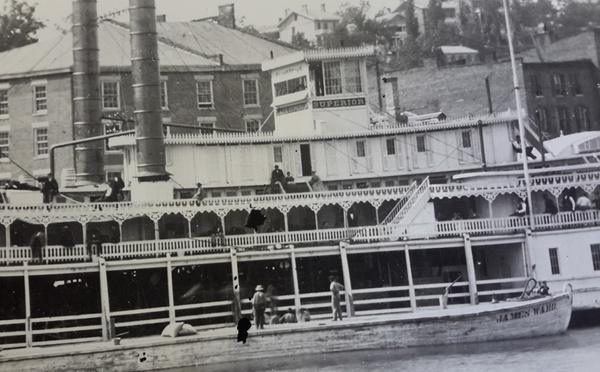
01. Introduction
Today, Galena is a 19th Century jewel known for its architecture, history, and hills. As you drive through Galena’s winding streets, you can’t help but admire the beautiful brick mansions seen throughout the town. But this was not always so. Galena got its humble beginning in the 1820s when it was first established as a lead mining community. Through luck and shrewd business dealings, it became the hub of a rich mining region. In the process it also became the gateway to the settlement of the Upper Mississippi. While you listen to the narratives, you can view on your screen historical photos from the Alfred Mueller collection, dating from the 1800’s to early 1900’s. Many more photos from Alfie’s collection are shared throughout the tours.

02. 1690-1820
It is not known exactly when lead was first mined in the Galena region, but Nicholas Perrot, a French trader, is credited with being the first white person to see Indian mines around 1690. The native peoples called the area Manitoumi or “the Land of God.” They used the lead ore for charms, body paint, and an item to trade. Most of the workers were women, children, and old men; the braves did the hunting and fishing. They kept their mines well-hidden for many years to discourage white settlers, whom they did not trust. They didn’t have sophisticated equipment; therefore, they just worked the deposits that were close to the surface using deer horns and other crude tools.

03. 1821- 1827
In 1822, the first lease in the Fever River country was granted by the federal government to Kentuckian Col. James Johnson, brother of Richard M. Johnson, future vice-President of the United States. He arrived on keelboats with twenty white miners. His mining operations drew much public attention. Soon, would-be miners, mostly frontier farmers from Kentucky and Tennessee, traveled up the Mississippi while those in southern Illinois followed Indian trails.

04. 1828-1839
The spring of 1828 saw 75 steamboat and 38 keel boat arrivals in Galena. Galena also saw its first serious flood, with steamboats floating down Main Street.

05. 1840- 1847
Perhaps Galena’s most colorful decade was the 1840’s. The new market created by the rising farm population, the steady growth of the city itself, and the continued increase in lead production, all made for free spending. The four-story buildings along Main were crammed with merchandise to be distributed throughout the Old Northwest Territory.

06. 1848- 1900's
Galena’s days, like those of the keelboat, were numbered. As early as 1848, a Galena editor had pointed out that the Fever River must be improved or other cities would get Galena’s trade. The rapid flow of settlers into the Upper Mississippi Valley was calling for larger steamboats, and it was becoming increasingly difficult, if not impossible, for steamboats to squirm up the narrow Fever River.

07. Conclusion
Galena’s hopes and dreams of being the “finest city of the West” were lost. Until now! Galena has fought hard to reclaim the title. Like many another mining community, Galena finds her greatest solace in a glory that is past.
